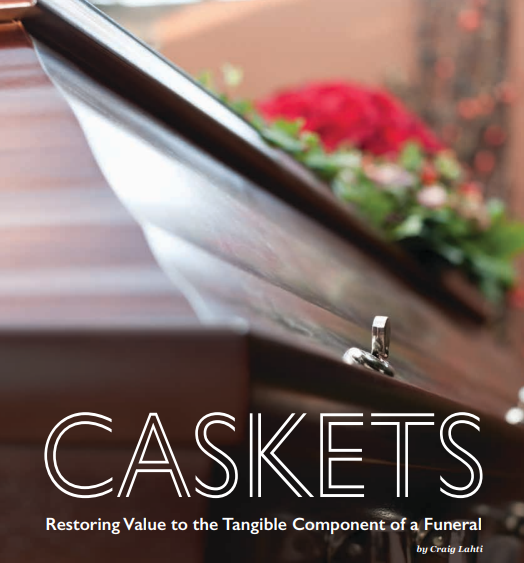(404) 312-6640
CASKETS: Restoring Value to the Tangible Component of a Funeral
Like doctors, attorneys, and many other professional occupations, the Funeral Director used to be the recognized, unquestioned authority on all things funeral-related. While we don’t have commercials advertising, “Have you talked to your funeral director about new alternatives to traditional burial,” there is a devaluing of the funeral service, and a primary target in the devaluation is the casket. Let’s evaluate what is happening and how we can regain control.
PRE-INTERNET DAYS
The funeral director could assist a family through the funeral planning process and make trusted recommendations on everything from casket spray to musical accompaniment and especially the casket that would best suit their loved one. For the casket selection, visual and physical representations of the caskets, materials used, and options were crucial to convey the value of the casket. Selection rooms were carefully merchandised to help educate the families on the features and benefits of the caskets. Between innovation in casket designs and features, as well as changes in color preferences, the selection room was the only way a family could learn about their options, and their trusted advisor, the funeral director, expertly guided the family to what casket truly honored and celebrated the life of their loved one.
SELF-RESEARCHED CONSUMERS TODAY
With the dawn of the internet, consumers across all industries began researching products, and services, and then assessing for themselves what value each held in their mind. Bloggers and other “experts” in the field from both a pro and anti-funeral sentiment helped influence disposition decisions. The expertise of the neighborhood funeral director whose family had served the community for generations was partially replaced by an “expert” the family read online. Manufacturer and funeral home websites showed pictures of the options and the value of the casket showroom in the funeral home diminished, people began questioning the need for 16-gauge, stainless steel, copper, or bronze, and they be gan embracing the concept of “it looks pretty and matches my budget.” Because so many families came in with preconceived ideas of what they wanted or needed or didn’t need, many funeral homes have transitioned from well-merchandised showrooms intended to educate and to help the family select a casket to a dust-collecting, outdated showroom where the families (and frankly the funeral directors) would prefer to not go to look at options and features, and they select from a basic catalog.
E-COMMERCE AND THE POTENTIAL TO ERODE RETAIL PRICES
Piggybacking off the online research and digital presentations made available by manufacturers, big box stores and e-retailers have attempted to reduce the highly symbolic and one of the most crucial parts of a funeral to a simple commod ity where the price is king. Promises of prompt delivery and satisfaction are attractive when combined with near wholesale prices, but where these businesses fall short is in properly educating the families on what they truly need. As Super Size Me showed us 20 years ago in the 2004 documentary, today’s Americans are redefining “average,” and without knowledge that their loved one is too large to fit a 24” wide interior, the family may select a budget casket that makes their loved one look more like a sardine than a beloved family member.
Other factors many families don’t consider are the risk of damage during shipping and having to use a damaged casket or if the service is the next day and a replacement cannot be sent, the family is forced into ordering through the funeral home as originally offered. Because of the substantial risk of damage when ordering online, many funeral homes are requiring a family member to be present upon delivery and unpacking to sign for and accept the condition of the casket, as the funeral home will not take responsibility for the casket they did not order or for which they did not pay. Families need to be aware of this and consider how valuable their time is in the days leading to the service. What level of risk are they willing to assume that their casket doesn’t arrive on time?
CHALLENGES OF TODAY’S FUNERAL DIRECTOR: “MY FAMILIES ARE BUYING DOWN, SO MY BEST SELLERS ARE PROMOS AND WHATEVER I CAN GET ON CLOSEOUT.”
I frequently hear about amazing promos being offered by manufacturers. When these promos are offered, particularly on minimum metal or entry-level quality caskets, they should be used as opportunities for increased profits, not at prices substantially below the rest of their lineup. The families should still benefit from increased affordability on select models, but what has happened in many markets is the funeral directors have an idea of what they need to make on their entry-level casket (whether dollar value or multiplier). When these same practices are applied to promo products, the rest of the caskets are devalued, and large price gaps develop between the promo products and the caskets with sim ilar features that are not on promo. When this gap exceeds $200, few families will see the increased visual value enough to “buy up,” so the funeral home has created the environment in which their families “buy down.” Do yourselves and your families a favor: Do not interject non-gasketed promos into your showroom or your presentation mix, and make sure the prices on these promos are not too irresistible for a family to pass up.
“MY FAMILIES DON’T BUY THAT...”
On one hand, funeral directors miss the days of manufacturers innovating and offering new products and features for personalization. Still, when innovation is introduced, many funeral directors will reply, “My families don’t buy/ don’t ask for that.” If they don’t know it is an option, they will not ask for it or buy it; however, if they are introduced to it, they may love it. When I was a kid, I thought brownies were a good dessert, but I couldn’t tell much difference between one recipe and another; however, when I was introduced to peanut butter in my brownies, my mind was blown. Not only did I want peanut butter in my brownies, but I wanted Jif Crunchy Peanut Butter in my Ghiradelli Ultimate Chocolate Brownies. The introduction of a simple ingredient elevated my satisfaction with what I was consuming. Likewise, many of the features and options introduced by manufacturers can increase family satisfaction and encourage them to buy up on the casket.
WHERE DO WE GO FROM HERE?
Once abdicated, a position of authority is difficult to reclaim, but it starts by establishing the role of expert and trusted advisor again. Educate your team on products to identify caskets that satisfy a variety of families. Need help? Ask your casket sales consultant for help understanding product offerings and trends. Remember the greatest NFL quarterbacks have position coaches. Your sales consultant can help you understand what is selling in your funeral home, the region, and perhaps even nationwide trends. Change your offerings to remain current. Adapt or die.
When it comes to helping the families select a casket, ask questions and listen. You know which caskets have special features. If the deceased loved his Ford F250 with RealTree Camo detailing and going hunting, he is not a minimum metal promo guy. He is a barn wood oak with camo interior. Start there. If the family’s funeral budget cannot afford the funeral with that high-profit casket, examine the low-profit, low-value services that could be adjusted to help increase the casket budget. The family has an idea of what they can afford for the funeral. While they may have found casket pricing online and have a preconceived notion of what they want to pay, they probably looked at something that would be “fine,” but will people look at the engineered wood promo and say, “That truly captures Bob?”
The casket is the most visible and tangible part of the funeral. Make it memorable. Help the families celebrate their loved ones. Don’t settle for the easy route of price. Choose to find the best match to honor the deceased.






Comments